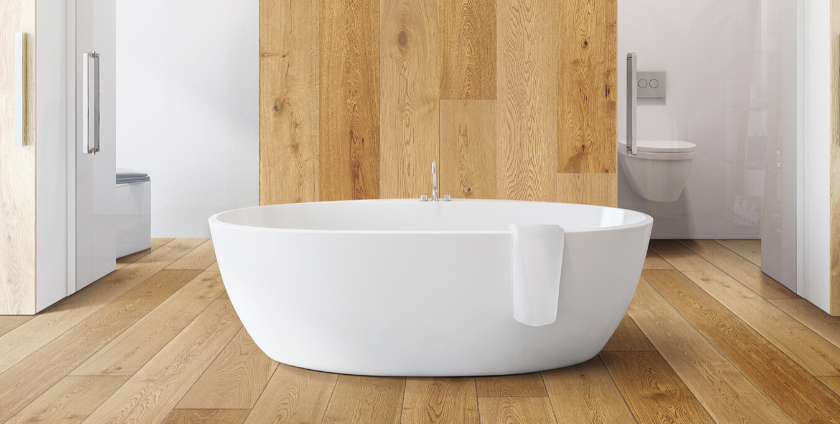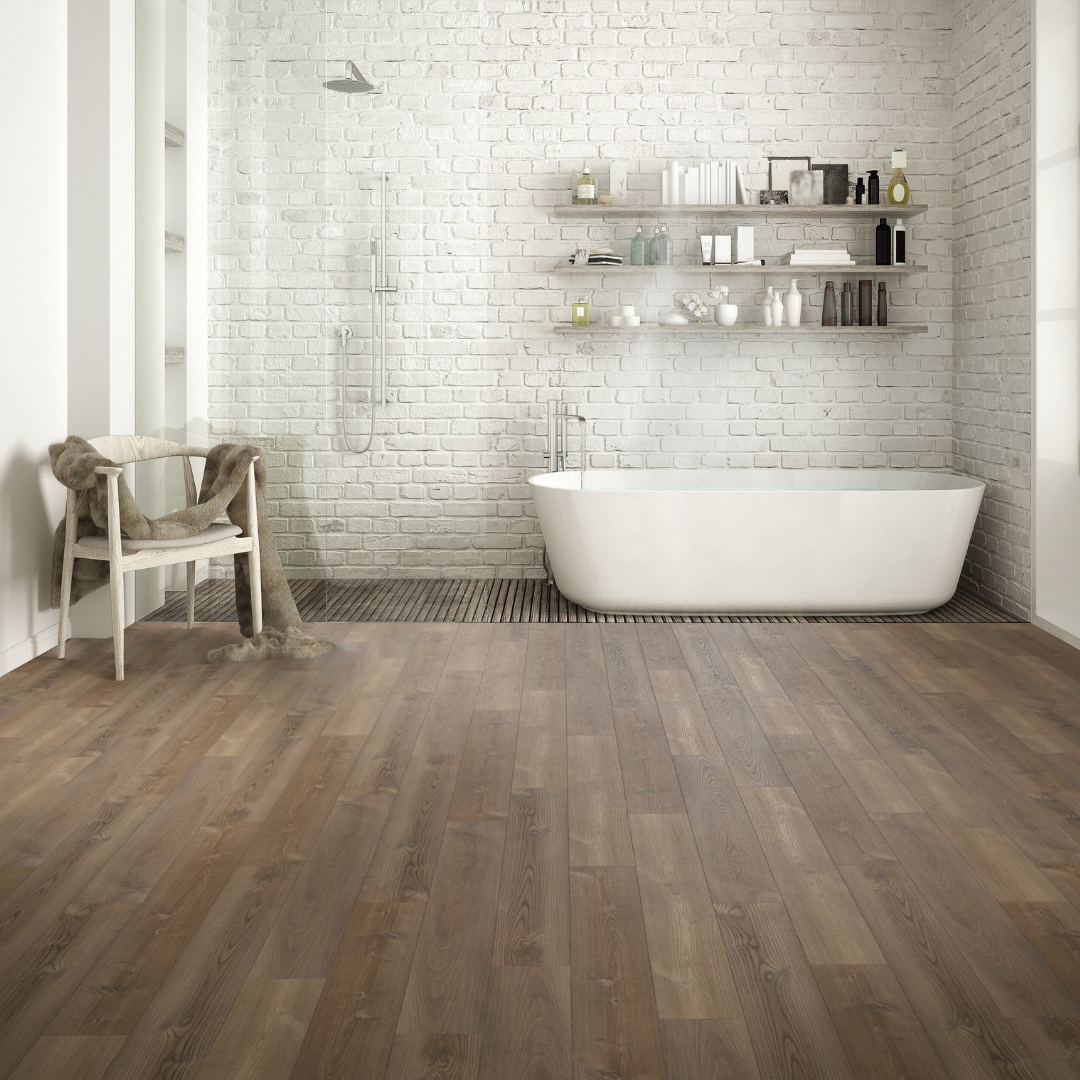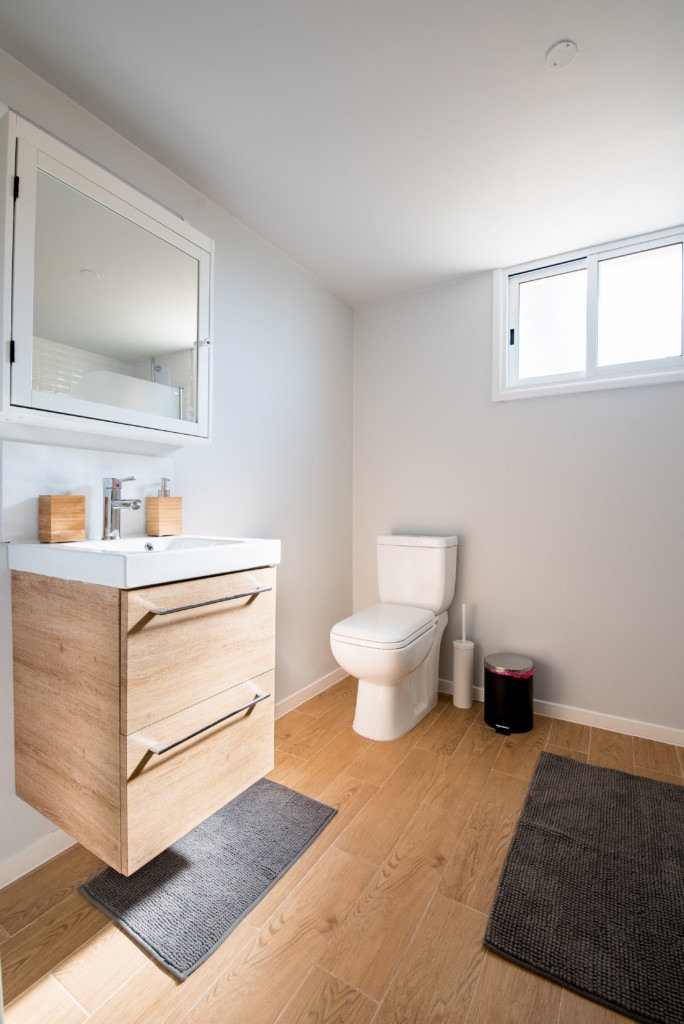Pros and Cons of Hardwood Flooring in Bathrooms
Hardwood flooring in the bathroom can be a bold and beautiful choice, but it’s not without its challenges. Let’s weigh the pros and cons to see if it’s the right fit for your space.
Aesthetic Appeal
Pros: Hardwood floors bring a timeless, elegant look to any room, including the bathroom. The natural beauty of wood adds warmth and sophistication that other materials struggle to match. It’s a fantastic way to make a statement and add value to your home.
Cons: The aesthetic appeal can be a double-edged sword. While it looks great, maintaining that pristine look in a moisture-heavy environment can be challenging. Water damage and humidity can cause the wood to warp or stain, diminishing its visual appeal over time.
Comfort and Warmth
Pros: Hardwood floors are warmer and more comfortable underfoot compared to tiles, especially in the chilly mornings. The natural insulation properties of wood can make your bathroom a more inviting space.
Cons: This comfort comes at a cost. The potential for water damage means you might need to invest in additional heating systems or rugs to protect the floor, which can offset the comfort benefits.
Durability and Longevity
Pros: High-quality hardwood floors can last for decades with proper care, making them a long-term investment. They can withstand heavy foot traffic and remain sturdy and beautiful for years.
Cons: In a bathroom setting, this durability is put to the test. Moisture and humidity can cause significant damage over time, leading to costly repairs or replacements. Ensuring proper ventilation and moisture control is crucial to maintaining the floor’s longevity.

Value Addition
Pros: Hardwood floors can increase the resale value of your home. Potential buyers often appreciate the classic look and durability of hardwood, making it an attractive feature in any room, including the bathroom.
Cons: The initial installation cost and the ongoing maintenance expenses can be high. If not maintained properly, the potential for water damage could negate the added value, making it a risky investment.
Customization Options
Pros: Hardwood comes in various species, finishes, and stains, allowing you to customize your bathroom to your exact taste. Whether you prefer a rustic oak or a sleek maple, there’s a hardwood option that will fit your vision.
Cons: The customization options can also mean a higher upfront cost. Exotic wood species and specialized finishes can quickly add up, making hardwood one of the more expensive flooring options.
Environmental Impact
Pros: Hardwood flooring is a natural and renewable resource, especially if you choose sustainably sourced wood. It can be an eco-friendly choice compared to synthetic materials.
Cons: The production and transportation of hardwood can have a significant environmental footprint. Additionally, the need for frequent replacements due to water damage can reduce the overall sustainability of the flooring choice.
Hardwood flooring in the bathroom offers a unique blend of beauty and comfort, but it’s essential to consider the potential challenges. By weighing these pros and cons, you can make an informed decision that balances aesthetics with practicality.
Types of Hardwood Suitable for Bathroom Use
Choosing the right type of hardwood for your bathroom is crucial to ensure both beauty and durability. Not all hardwoods are created equal, especially in a moisture-rich environment. Let’s explore the best types of hardwood for bathroom use.
Teak
Teak is often considered the gold standard for bathroom hardwood flooring. It’s naturally resistant to water and humidity, making it an excellent choice for bathrooms. The oils in teak wood help repel moisture, preventing warping and rot.
Pros: Teak’s natural water resistance and durability make it ideal for bathrooms. It also has a beautiful, rich color that adds warmth and elegance to any space.
Cons: Teak is one of the more expensive hardwood options. Its high demand and limited supply contribute to the higher cost, but many find the investment worthwhile.
White Oak
White oak is another great option for bathroom flooring. It’s less porous than red oak, making it more resistant to water damage. Its dense grain and natural hardness make it durable and long-lasting.
Pros: White oak’s tight grain and hardness provide excellent resistance to moisture and wear. It’s also more affordable than teak, offering a good balance between cost and durability.
Cons: While more water-resistant than some other hardwoods, white oak still requires proper sealing and maintenance to ensure longevity in a bathroom setting.
Cedar
Cedar is known for its natural resistance to moisture, insects, and decay. It’s commonly used in saunas and outdoor furniture, making it a good candidate for bathroom flooring.
Pros: Cedar’s natural properties make it highly resistant to moisture and rot. It also has a pleasant aroma and a beautiful, distinctive grain that adds character to your bathroom.
Cons: Cedar is softer than other hardwoods, which means it can be more prone to scratches and dents. Regular maintenance and care are necessary to keep it looking its best.
Brazilian Walnut
Brazilian walnut, or Ipe, is a super-dense and durable hardwood that’s highly resistant to water and decay. It’s often used in outdoor decking, which speaks to its toughness.
Pros: Ipe’s exceptional hardness and water resistance make it perfect for bathrooms. It also boasts a stunning, dark appearance that adds a touch of luxury to your space.
Cons: Ipe is one of the most expensive hardwood options, and its density can make installation more challenging. However, its durability often justifies the higher cost.
Bamboo
Although technically a grass, bamboo is often considered in the hardwood category due to its similar properties and appearance. It’s highly sustainable and can handle moisture well.
Pros: Bamboo is eco-friendly, renewable, and offers good moisture resistance when properly treated. It’s also relatively affordable and comes in various styles and finishes.
Cons: Not all bamboo flooring is created equal. Ensure you choose high-quality, strand-woven bamboo that’s been properly treated for moisture resistance to avoid issues with warping.
Engineered Hardwood
While not a specific wood type, engineered hardwood is worth mentioning. It’s made by bonding a thin layer of hardwood over a plywood base, making it more stable in humid environments.
Pros: Engineered hardwood’s construction provides better resistance to moisture and temperature changes. It offers the look of real wood with added durability.
Cons: The thin layer of hardwood means it can’t be sanded and refinished as many times as solid hardwood. Proper care and maintenance are essential to ensure its longevity.
Choosing the right hardwood for your bathroom involves balancing aesthetics with practicality. Teak, white oak, cedar, Brazilian walnut, bamboo, and engineered hardwood each offer unique benefits, allowing you to find the perfect fit for your bathroom’s style and needs.
Protective Finishes and Treatments
When it comes to installing hardwood floors in a bathroom, one of the most critical aspects is ensuring they are well-protected against moisture and humidity. The right finishes and treatments can make all the difference in extending the life and beauty of your hardwood floors. Let’s explore some of the best options.
Polyurethane Finish
Polyurethane is a popular choice for sealing hardwood floors, providing a strong, clear, and durable finish. There are two main types: oil-based and water-based.
Pros: Polyurethane offers excellent protection against moisture, scratches, and stains. Oil-based versions tend to be more durable and impart a warm, amber tone, while water-based options dry faster and have less odor.
Cons: Oil-based polyurethane can be yellowed over time and has a strong smell during application. Water-based polyurethane, while less odorous, may require more coats to achieve the same level of protection.
Marine-Grade Spar Varnish
Spar varnish, often used on boats, is designed to withstand harsh marine environments. It’s highly resistant to water and UV damage, making it a robust option for bathroom hardwood floors.
Pros: Marine-grade spar varnish provides superior water resistance and flexibility, allowing the wood to expand and contract without cracking. It also adds a rich, glossy finish.
Cons: This finish can be more expensive and harder to find than standard polyurethane. The application process may also be more time-consuming, requiring multiple coats and careful sanding between layers.
Penetrating Oil Seals
Penetrating oils, like tung oil or linseed oil, soak into the wood, providing a natural-looking finish while enhancing water resistance.
Pros: These oils give the wood a rich, deep color and a soft, matte finish. They also help to maintain the wood’s natural feel and texture while providing a degree of water resistance.
Cons: Penetrating oils require more frequent reapplication compared to polyurethane or varnish. They also provide less protection against scratches and stains, making them better suited for lower-traffic areas.
Hardwax Oil
Hardwax oil combines the benefits of natural oils and waxes, creating a durable and water-resistant finish that enhances the wood’s natural beauty.
Pros: Hardwax oil is easy to apply and maintain. It provides a beautiful, natural finish that enhances the wood grain while offering good water resistance. It’s also less likely to show scratches and wear.
Cons: While durable, hardwax oil doesn’t offer the same level of protection as polyurethane or spar varnish. It may require more frequent touch-ups and maintenance in high-moisture areas like bathrooms.
Sealant Additives
Adding a sealant or waterproofing additive to your finish can provide extra protection against moisture. These products can be mixed with your chosen finish to enhance its water-resistant properties.
Pros: Sealant additives can significantly improve the moisture resistance of standard finishes. They are easy to use and can be mixed with various types of finishes, including polyurethane and varnish.
Cons: The effectiveness of sealant additives can vary depending on the product and the base finish used. It’s essential to follow the manufacturer’s instructions carefully for the best results.
Regular Maintenance and Reapplication
Regardless of the finish you choose, regular maintenance is crucial to keeping your hardwood bathroom floors in top condition. This includes periodic cleaning, reapplication of finishes, and prompt attention to any water spills or damage.
Pros: Consistent maintenance helps extend the life of your hardwood floors and keeps them looking beautiful. It also allows you to address any issues early before they become more significant problems.
Cons: Maintenance can be time-consuming and requires a commitment to regular care. However, the effort is well worth it to preserve the beauty and functionality of your hardwood floors.
Choosing the right protective finishes and treatments for your bathroom hardwood floors is essential to ensure their durability and longevity. Polyurethane, marine-grade spar varnish, penetrating oils, hardwax oil, sealant additives, and regular maintenance all play a role in keeping your floors beautiful and protected against moisture.
Can You Install Wide Plank Floors in the Kitchen or Bathroom?
Related Posts:





